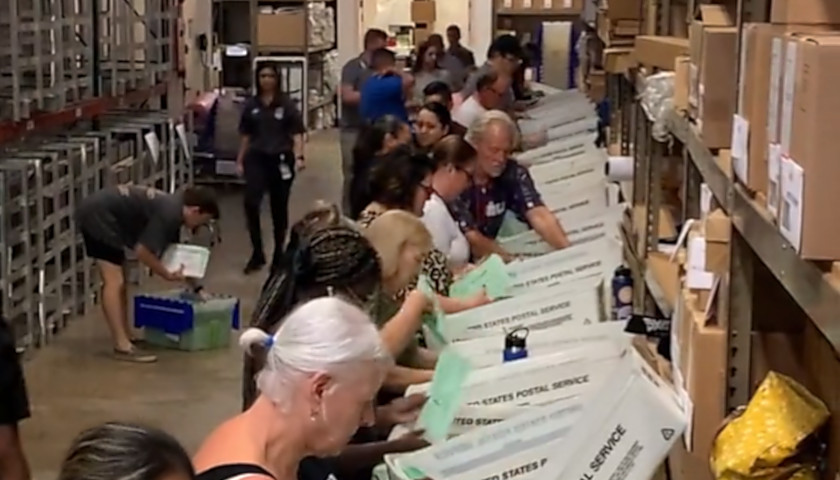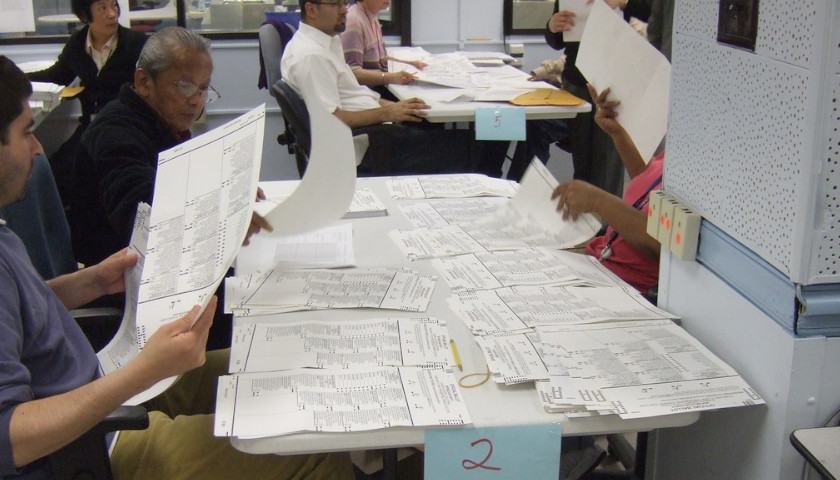As the final remaining ballots in Maricopa County trickle in for counting, concerns are arising over the tabulation procedures. Some of the most Republican-dominant batches of ballots were not counted until the very end, sparking accusations that the order of counting was deliberately manipulated.
Pam Kirby, executive director of the Arizona Republican Party, tweeted on Sunday, “I’m old enough to remember back in 2010 and 2014 when Maricopa County Elections reported > 95% of the ballots on Election Night and there were just a few trickles the day after that didn’t change the results. What changed? #MaricopaCounty #Election2022.”
The first ballots counted from the election were early ballots, the ones mailed in and received by Friday, November 4 by 5 p.m. Those totals were announced shortly after 8 p.m. on election night. The next votes counted were the ones cast in person on Election Day along with early ballots that were returned after November 5. Finally, provisional ballots, including those that needed to be cured, which means correcting some mistake like an unmatching signature or lack of ID, are counted.
Over one-third of the polling locations in the county reported problems with the tabulators due to printer issues. The “misread” ballots that had problems going through the tabulation machines on Election Day are being processed last. They were placed in “door 3” boxes, but when election workers ran out of those boxes, they placed them in black satchels, causing concern that they were commingled with regular ballots — particularly ballots that had already been tabulated — not properly identified as problematic, not secured (observers say they saw “white ties” on the satchels), or lacking chain of custody. Election fraud denier Bill Gates, chair of the Maricopa County Supervisors, assured voters that the misread ballots were placed in a “secure box.”
U.S. Senate candidate Blake Masters accused the county of commingling the misread ballots with ballots that had already been counted at least twice. He said in order to resolve it, “I think the most honest thing at this point would be for Maricopa County to wipe the slate clean, just take all the ballots and do a fresh count.”
Republican Abe Hamadeh, who was trailing his Democratic opponent Kris Mayes for attorney general by just 771 votes Tuesday evening, tweeted on Saturday, “REMEMBER: 72%+ of the votes on Election Day in person were Republican. When you have 30% of the tabulating machines failing, causing people to leave the lines and give up, this is voter suppression targeting a political party.”
After the problem emerged on voting day, Maricopa County Recorder Stephen Richer issued an apology and explained how it wasn’t under his jurisdiction, it was the Maricopa County Supervisors’ responsibility. He tweeted, “State statute has long governed the division of labor in Arizona election administration. Broadly speaking, the County Recorder is responsible for voter registration and early voting. The Board of Supervisors is responsible for Emergency Voting, Election Day operations, and tabulation.”
After the ballots are cast or dropped off at the voting centers, bipartisan teams of ballot couriers transport the ballots to the Maricopa County Tabulation Election Center (MCTEC). The couriers complete a ballot transport statement, which includes a signature from someone running the polling location in order to provide a chain of custody, and seal the boxes.
At the tabulation center, the number of incoming ballots is logged, but then they are sent off to Runbeck Election Services, a third-party signature verification company. Maricopa County is the only county in Arizona that uses a third-party service to verify signatures; the rest of the counties handle it all in-house at their county elections departments. Runbeck scans the outside of the envelopes to obtain an image of the signatures. Those images are then sent to MCTEC to compare to the voters’ signatures on file. Once verified, MCTEC workers open the envelopes and start the tabulation process.
Maricopa County Elections Communications Director Megan Giberton caused a stir in June when she told The Sun Times that MCTEC scans the ballots when they first arrive — implying they are opened before the signatures have been verified, which is a violation of law.
Runbeck has come under fire for using AI for signature verification. Jennifer Wright, the Arizona Attorney General Office’s Election Integrity Unit attorney, sent Maricopa County Recorder Stephen Richer a letter on May 4 expressing her concern over emails between his office and Runbeck discussing how AI is used to assign confidence levels to different batches of emails. Wright believes the use of AI for signature verification violates the law.
Apparently as a result of adjusting the level of similarity used by AI in signature verification, “bad” signatures were rejected 14 times more often during the August primary election in Maricopa County than during the 2020 general election.
Maricopa County switched from polling locations in precincts to larger vote centers in 2018. A voter can go to any vote center in the county and cast a vote, since a custom ballot is printed out for them when they arrive. The Arizona Legislature passed a law authorizing vote centers in 2011, and 12 counties now use them, including Pima County, which switched to them this year.
Most of the races in Arizona have been called by major news outlets except the attorney general’s race. Kari Lake and some other Republicans who lost are expected to file lawsuits within the next few days.
– – –
Rachel Alexander is a reporter at The Arizona Sun Times and The Star News Network. Follow Rachel on Twitter. Email tips to [email protected].
Photo “Maricopa County Ballot Processing” by Maricopa County.





